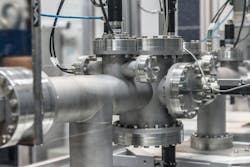The Deal on Dewatering
Updated 1/18/21
Wellpoint dewatering is the process of removing groundwater temporarily from soils in a localized area to complete the construction of a foundation, pipeline or other below-ground structure or to perform soil remediation.
Typical wellpoint dewatering applications include:
- Land remediation;
- Pollutant reclamation;
- Laying deep sewer, water or utility lines;
- Excavation and lining work for canals and channels;
- Excavations for basements, structures and foundations of buildings; and
- Foundations of dams, bridges, powerhouses and underground tanks.
Learning the System
A series of shallow wells known as wellpoints are installed at a pre-determined depth and appropriately spaced along a trench or around an excavation site. Dewatering experts employ several installation techniques, including installing, or jetting by high pressure water, the wellpoints by hand, using a casing or punch, and drilling methods such as augers and drill rigs.
The installed wellpoint reaches the surface via a riser pipe, which is in turn connected to a common header pipe main through a clear, flexible swing joint that incorporates an adjustable header valve. The swing joint provides a clear view of what is being pumped, and the valve allows control of the air entering the system. Lastly, the header pipe is connected to a wellpoint pump.
The vacuum produced by the pump draws water through notches in the wellpoints. The water then travels from the wellpoints through the swing joints into the header pipe to the pump. It is then discharged away from the site or to other processes to remove unwanted properties such as contaminants.
Considered the oldest method of practical pre-drainage in general use for more than 80 years, wellpoint dewatering is versatile and works well in most types of formations, as the depth and spacing of wells can be controlled and the amount of vacuum to each wellpoint can be varied to accommodate site conditions.
In the Planning Stages
System design depends on many factors, from soil conditions, methods of construction and header elevation to water volume, pump and discharge location. Surface drainage and wellpoint depth considerations also must be taken into account. Single-stage wellpoint systems have an effective suction lift of 15 ft at sea level, and under certain circumstances, lifts can be increased to as much as 22 ft. The wellpoint system is utilized to dewater soils drained by gravity flows with a drawdown limited to an average of 18 ft per stage; however, several stages may be used in one system. Wellpoints typically have capacities ranging from a fraction of a gallon per minute (gpm) to 100 gpm.
Wellpoint dewatering is best suited for relatively shallow excavations in stratified soils and permeable sandy soils, though it can effectively dewater coarse sands and gravels, silts and some clays. Stratified soils consist of layers of different soil textures. Rapid-moving water deposits gravel and coarse sand. Slow-moving water deposits fine sand and silt. Still water deposits the finest clay materials. Water does not move uniformly downward in stratified soils.
The difference created between the pressure of the groundwater (atmospheric pressure) and the filters (wellpoints) directs the groundwater flow towards the wellpoints at a velocity that depends on the permeability of the various types of ground. When the wellpoint system in a given section pumps more water than filters through the voids, the water table begins to lower, forming a conical surface. As pumping continues, the dewatered area increases until the capacity removed by the wellpoint system is equal to the capacity due to filtration. At this point the water table stabilizes, forming the “cone of influence.” The size of this cone is closely linked to the permeability of the ground and therefore will be larger in low-permeability ground.
Shallow water tables are susceptible to pollution. Drain fields, dry wells, animal wastes and fertilizer applications can contaminate a shallow water table. Recharge is usually from rainfall, falling directly above and percolating downward to the water table. As the water moves downward, it may carry contaminants. Environmental remediation requires understanding the safety of addressing a potentially harmful situation in a speedy, accurate and efficient manner. Wellpoint dewatering can be employed to effectively aid in remediating these contaminants.
There are professional dewatering and pump companies that offer complete groundwater control services, including site investigation, design, calculations and comprehensive subsoil knowledge, along with recommendation and installation of appropriate dewatering systems.
A professional’s first step in planning a wellpoint dewatering system is to meet with the project engineer and job foreman to acquire pertinent information, then gather soils and watershed information from soil borings and other available resources. The next step is to evaluate and note topography, including reviewing underground utilities, examining intervening water sources and reviewing the equipment needed and labor required.
Pump Selection
As water is collected, a high proportion of air is collected as well. Wellpoint pumps, such as a rotary, vacuum, piston and vacuum-assisted, are designed specifically with high air-handling capability to manage groundwater, air and soluble gases.
From filtration to remediation, pumps handle various caustic elements in an effort to keep potentially harmful liquids under control. The larger the pump, the quicker a site can be dewatered. Additionally, more than one pump can be added to a system. In wellpointing, control of air is important, as excessive air causes cavitation, which reduces pump efficiency.
Fluid Discharge Best Practices
Today, it is common before releasing dewatering discharge to rivers, lakes or wetlands to filter the discharge through bags made of geotextile fabric. Sediment and erosion control is impeded by the use of dewatering and sediment filter bags for pumping and filtering sediment-laden water. These bags retain solids, sediment and other particles, allowing only clean water out of the bag.
Additionally, it is a best practice to minimize the dewatering discharge velocity to avoid scouring the receiving area, and design structural controls such as basins or sumps that receive discharge water to handle the anticipated discharge flow.
Download: Here
